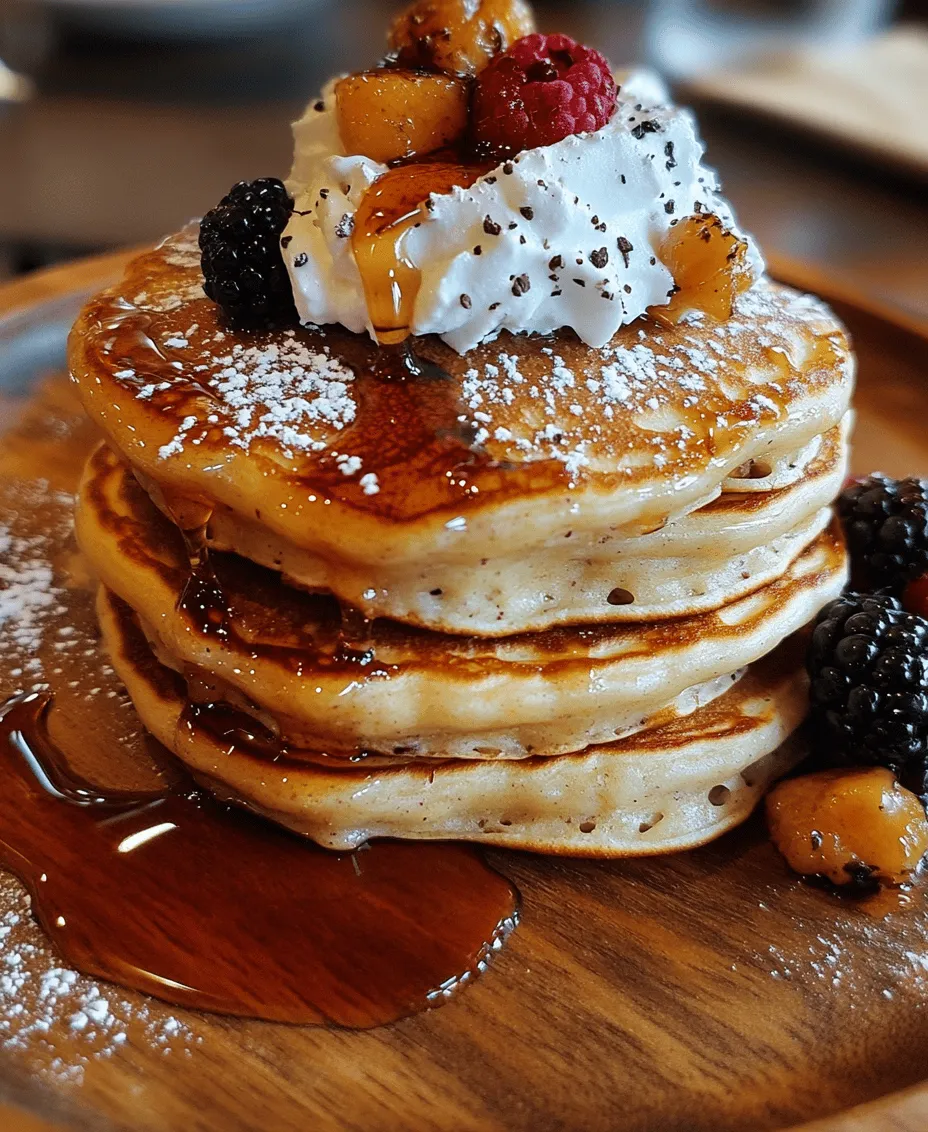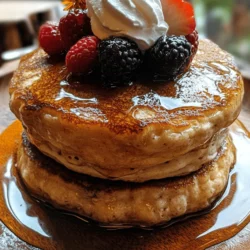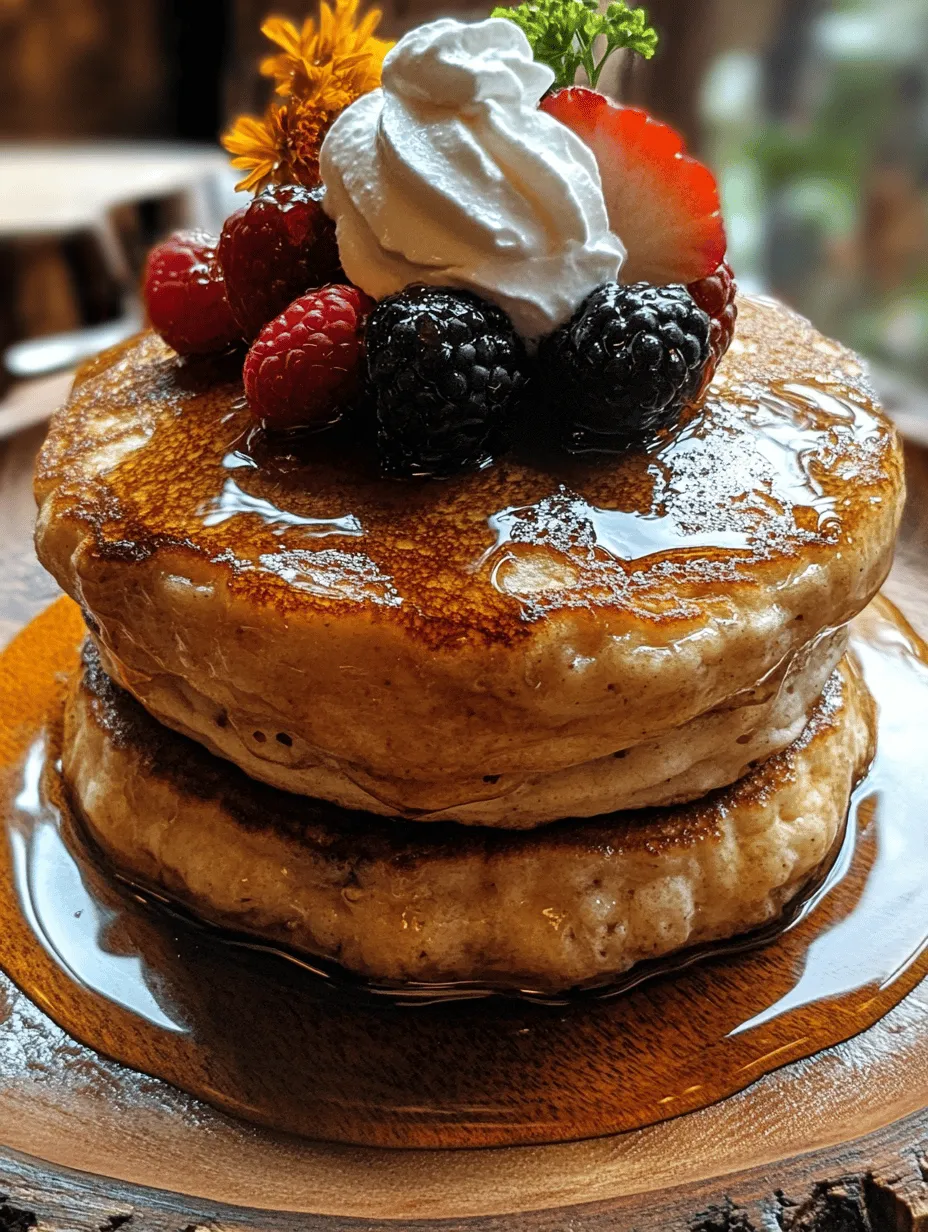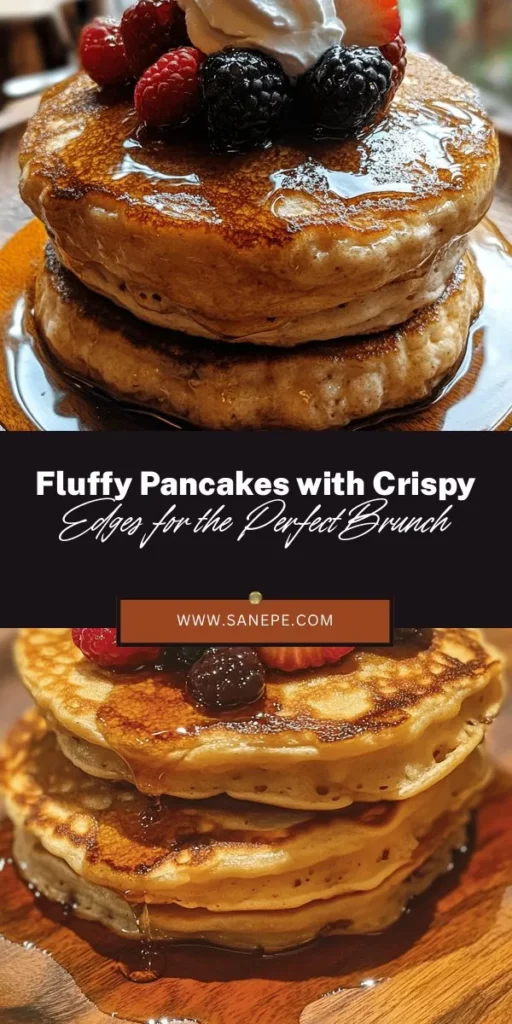Introduction
Fluffy pancakes with crispy edges are a breakfast favorite that brings joy to many. There’s something undeniably comforting and satisfying about a stack of pancakes, especially when they are perfectly fluffy and have that delightful crispy edge. This recipe promises to deliver pancakes that are soft and airy on the inside while having that satisfying crispiness on the edges. Whether you are treating yourself to a lazy weekend morning or hosting a special brunch gathering, these pancakes are sure to impress.
The origins of pancakes date back centuries, with variations found in cultures all around the world. From French crêpes to American flapjacks, the basic concept of combining flour, liquid, and a leavening agent has stood the test of time, evolving into the delicious fluffy pancakes we know today. This guide will walk you through the process of creating these delicious pancakes, including helpful insights about the ingredients and tips for perfecting your technique.
Understanding the Ingredients
To achieve the perfect fluffy pancakes with crispy edges, it is essential to understand the role of each ingredient in the recipe. By selecting the right components and combining them properly, you can elevate your pancake game to new heights.
All-Purpose Flour
All-purpose flour is the backbone of any pancake recipe. Its gluten content provides the necessary structure while allowing the pancakes to rise beautifully. When mixed with liquid, the proteins in the flour begin to develop gluten, creating a network that traps air bubbles produced by the leavening agents. This process is crucial for achieving that light and fluffy texture that is characteristic of great pancakes. Opt for a high-quality all-purpose flour for the best results, and consider sifting it before use to aerate it further, promoting an even lighter pancake.
Sugar
Sugar is not just a sweetener in pancake recipes; it also plays a vital role in the overall flavor and texture. When sugar is added to the batter, it caramelizes during cooking, contributing to the lovely golden-brown color and crispiness of the edges. Additionally, sugar enhances the flavor profile of the pancakes, making them more enjoyable. For a balanced sweetness, granulated white sugar is commonly used, but you can experiment with other types like brown sugar or coconut sugar for a different taste.
Baking Powder
Baking powder is the key leavening agent in this fluffy pancake recipe. It consists of a combination of an acid and a base, which react when moistened and heated, producing carbon dioxide gas. This gas forms bubbles in the batter, causing it to rise and become light and airy. The right amount of baking powder is essential; too little will result in dense pancakes, while too much can lead to a metallic taste. Always ensure your baking powder is fresh for optimal results.
Salt
Salt is often overlooked in sweet recipes, but it plays a critical role in balancing flavors. In pancakes, a pinch of salt enhances the sweetness of the sugar while adding depth to the overall flavor. It also helps to control yeast activity in recipes that require fermentation. A little salt goes a long way in elevating your pancakes from good to fantastic.
Eggs
Eggs are a crucial ingredient in pancake batter, providing moisture, richness, and structure. They act as a binding agent, holding the other ingredients together while contributing to the overall fluffiness of the pancake. When beaten, eggs incorporate air into the batter, further aiding in the leavening process. For the best results, use large eggs at room temperature, as they blend more easily with the other ingredients.
Buttermilk
Buttermilk is a game-changer in pancake recipes. Its acidity not only tenderizes the gluten in the flour, resulting in a softer texture, but it also reacts with baking powder to create additional lift. The tangy flavor of buttermilk adds a delightful complexity to the pancakes, making them taste exceptional. If you don’t have buttermilk on hand, you can easily make a substitute by mixing milk with a tablespoon of vinegar or lemon juice and letting it sit for a few minutes.
Unsalted Butter
Melted unsalted butter brings richness and moisture to the pancake batter. It adds flavor and contributes to the crispiness of the edges as the pancakes cook. Using unsalted butter allows you to control the salt content in your recipe more effectively. For the best flavor and texture, melt the butter gently and allow it to cool slightly before adding it to the batter.
Vanilla Extract
Vanilla extract is the secret ingredient that elevates the flavor of your pancakes. A splash of pure vanilla extract adds warmth and complexity, making each bite more delightful. While it’s optional, we highly recommend including it for an aromatic and flavorful experience.
Optional Toppings
One of the best parts of making pancakes is the endless variety of toppings you can choose from. Fresh fruits like blueberries, strawberries, or bananas add natural sweetness and a pop of color. A drizzle of honey or pure maple syrup can enhance the flavor while providing that satisfying sweetness. For a decadent touch, consider adding whipped cream or a dollop of yogurt. The possibilities are endless, allowing you to customize your pancakes to suit your taste preferences.
Step-by-Step Instructions
Now that you have a solid understanding of the ingredients, it’s time to dive into the step-by-step instructions for making perfect fluffy pancakes with crispy edges. Following these steps will ensure that your pancakes are light, airy, and full of flavor.
Preparing the Dry Ingredients
Start by measuring out the dry ingredients. In a mixing bowl, combine the all-purpose flour, sugar, baking powder, and salt. Whisk these ingredients together until they are evenly distributed. This step is crucial as it ensures that the leavening agent (baking powder) is evenly mixed throughout the flour, leading to consistent rising and texture across your pancakes.
Take care to avoid overmixing the dry ingredients. You want them to be well combined, but not clumped together. This will set the stage for the next steps, where you will add the wet ingredients and achieve the perfect pancake batter consistency.
Continue to the next steps, where you’ll incorporate the wet ingredients and eventually create the perfect batter for your fluffy pancakes. With a solid base of knowledge about your ingredients and their purposes, you’re well on your way to enjoying a delicious stack of fluffy pancakes with crispy edges.

Mixing the Wet Ingredients
To achieve the perfect fluffy pancake, the first step is to blend the wet ingredients correctly. Begin by cracking two large eggs into a mixing bowl. Use a whisk to beat the eggs gently until the yolks and whites are fully combined, creating a uniform mixture. Next, add 1 cup of buttermilk and 2 tablespoons of melted butter (cooled to room temperature). If you don’t have buttermilk, you can make a substitute by mixing 1 cup of milk with 1 tablespoon of vinegar or lemon juice; let it sit for about five minutes before using.
Whisk these ingredients together until smooth, ensuring that there are no lumps of butter remaining. The smoothness of your wet mixture is crucial, as it ensures better incorporation with the dry ingredients later on. This step lays the foundation for achieving the desired fluffy texture in your pancakes.
Combining Wet and Dry Ingredients
With your wet and dry ingredients prepared, it’s time to combine them. Make a well in the center of your dry ingredients and pour the wet mixture into it. Using a spatula or wooden spoon, gently fold the ingredients together. It is essential to mix just until the dry ingredients are incorporated; overmixing will lead to tough pancakes.
The key here is to leave some small lumps in the batter. These lumps indicate that the gluten in the flour hasn’t been overworked, allowing the pancakes to rise beautifully when cooked. Keep the mixing light and airy, ensuring that any dry pockets of flour are fully integrated without turning the batter into a homogeneous mixture.
Cooking the Pancakes
Once your batter is ready, it’s time to cook the pancakes. Preheat your skillet or griddle over medium heat. If you’re using a non-stick skillet, there’s no need for additional grease; however, for cast-iron skillets, lightly grease the surface with a small amount of oil or butter to prevent sticking.
To test if the skillet is hot enough, sprinkle a few drops of water onto the surface. If they sizzle and evaporate quickly, your skillet is ready. Pour about 1/4 cup of batter onto the skillet for each pancake. The batter should spread slightly, but not too much.
For crispy edges, let the pancakes cook undisturbed for about 2-3 minutes. You’ll know they’re ready to flip when bubbles form on the surface and the edges appear set.
Flipping the Pancakes
Timing is crucial when it comes to flipping your pancakes. To ensure optimal cooking, use a spatula to gently lift one edge of the pancake to check for a golden-brown color. If it looks good, slide the spatula underneath and flip it over quickly but gently.
Cook the second side for another 1-2 minutes, until it is golden brown as well. If your pancakes are browning too quickly, reduce the heat slightly to allow them to cook through without burning. Repeat the process for the remaining batter, adjusting the heat as necessary to maintain an even cooking temperature.
Serving Suggestions
Presentation can elevate your fluffy pancakes into a delightful breakfast experience. Stack your pancakes high on a plate, and add a pat of butter on top to melt into the warm layers. Drizzle with warm maple syrup or honey for a sweet touch.
For added flair, consider garnishing with fresh fruits such as sliced bananas, strawberries, or blueberries. A sprinkle of powdered sugar can provide a touch of elegance, and for a bit of crunch, add some chopped nuts or granola.
Don’t forget to serve alongside a dollop of whipped cream or yogurt for a creamy contrast that enhances the overall flavor profile of the dish.
Tips for Perfecting Your Pancakes
Achieving the perfect pancake requires attention to detail and a few additional tricks. Here are some insights to help you achieve the best results.
Avoiding Overmixing
Understanding the science behind overmixing is essential for pancake perfection. When flour is mixed with liquid, gluten begins to develop. While gluten helps with structure, too much can lead to dense, chewy pancakes rather than the desired light and fluffy texture. Stick to gentle folding until the dry ingredients are just incorporated, leaving small lumps in the batter.
Temperature Control
Maintaining the right skillet temperature is crucial for even cooking. If the heat is too high, the pancakes may burn on the outside while remaining raw in the middle. Conversely, if the heat is too low, they can become dry. Adjust the temperature as needed, and ensure your skillet is consistently heated throughout the cooking process for the best results.
Experimenting with Add-ins
Once you’ve mastered the base pancake recipe, don’t hesitate to experiment with add-ins to elevate your breakfast. Chocolate chips or chunks can add a delightful sweetness, while nuts impart a satisfying crunch. You can also mix in spices such as cinnamon or nutmeg for a warm flavor twist. For a fruity option, consider folding in blueberries or diced apples directly into the batter.
Nutritional Information
When enjoying fluffy pancakes, it’s essential to be mindful of their nutritional aspects. Here’s a brief overview of what you can expect.
Caloric Breakdown
A standard serving of fluffy pancakes (approximately 2-3 pancakes) contains around 300-400 calories, depending on the ingredients used and the portion size. This includes the calories from the flour, eggs, milk, and any added toppings such as syrup or butter.
Healthier Substitutions
For those looking to make healthier choices, several substitutions can be made. For instance, you can replace all-purpose flour with whole wheat flour or almond flour to increase fiber content. You may also consider using a sugar substitute or reducing the amount of sugar in the recipe. Opting for low-fat milk or a non-dairy alternative can further reduce calorie counts while still providing a delicious outcome.
Conclusion
Fluffy pancakes with crispy edges are not just a breakfast item; they are a delightful experience that can be easily made at home. By understanding the ingredients, following the step-by-step instructions, and applying the tips shared, you can create pancakes that are not only delicious but also visually appealing. Whether enjoyed plain or adorned with your favorite toppings, these pancakes are sure to satisfy your breakfast cravings and become a staple in your kitchen.
With a little practice and experimentation, you’ll soon find yourself mastering the art of pancake making, impressing family and friends with your culinary skills, and enjoying this timeless breakfast classic at any time of day. So gather your ingredients, fire up the skillet, and let the pancake-making adventure begin!


